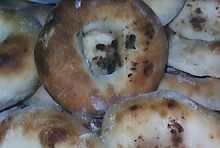Kossar's Bialys
| Kossar's Bialys | |
|---|---|
|
Kossar's Bialys | |
| Restaurant information | |
| Established | 1936 |
| Current owner(s) | Evan Giniger and David Zablocki |
| Food type | Bakery |
| Street address | 367 Grand Street (and Essex Street), Lower East Side, Manhattan |
| City | New York City |
| State | New York |
| Country | United States |
| Coordinates | 40°42′59″N 73°59′20″W / 40.716446°N 73.988792°W |
| Website | Kossar's Bialys Web site |
Kossar's Bialys (Kossar's Bialystoker Kuchen Bakery) located at 367 Grand Street (and Essex Street), on the Lower East Side in Manhattan, New York City, is the oldest bialy bakery in the United States.[1][2]
Background

The bialy gets its name from the "Bialystoker Kuchen" of Białystok, Poland (at the time under Russian occupation). Russian Jewish bakers who arrived in New York City in the late 19th century and early 20th century made an industry out of their recipe for the mainstay bread rolls baked in every household.[3]
Kossar's Bialys, known as Mirsky and Kossar's[4] when Isadore Mirsky and Morris Kossar founded it in 1936, is one of the few remnants of what was once its own industry in New York City with its own union association, the Bialy Bakers Association, Inc.[5]
Originally located on Clinton Street in Manhattan's Lower East Side, Kossar's Bialys moved to its current location at Grand and Essex Streets in the early 1960s after a union dispute and subsequent fire destroyed the building.[5][6]
Kossar's Bialys was the starting point for former New York Times food critic Mimi Sheraton's research for her 2002 book, The Bialy Eaters: The Story of a Bread and a Lost World.[7]
Present day

In 2013, Evan Giniger and David Zablocki purchased the bakery from Juda and Debra Engelmayer and Daniel Cohen.
The prior ownership, Juda and Debra Engelmayer and Daniel and Malki Cohen, had purchased the bakery from Morris Kossar's son-in-law and daughter, Daniel and Gloria Kossar Scheinin in 1998.[8][9]
Kossar's Bialys also makes bulkas (small hero sandwich size loaves), pletzels ("onion boards"—focaccia-like flatbreads smothered in onion and poppyseeds), sesame sticks and other baked goods.
Kossar's Bialys is on the Lower East Side and Lower Manhattan tour circuit.[8][10]
See also
References
- ↑ "Food on the Lower East Side: Kossar's Bialys". Lower East Side Tenement National Historic Site website.
- ↑ Colleen McKinney. "Profile: Kossar's Bialys". New York Magazine.
- ↑ Paul Solman (WGBH-TV Boston) (April 5, 2001). "Baking History". The NewsHour with Jim Lehrer.
- ↑ Allegra Jordan Young (Winter 2006). "Roy Mersky and the Future of Libraries" (PDF). UT Law, the magazine of the University of Texas School of Law (Cover story, p. 26).
- ↑ 5.0 5.1 "Suspicious Blast Damages Bakery". The New York Times Business Financial section, Page 52 (abstract). February 20, 1958.
The Local had been striking since Feb. 1 against Kossar’s and six other bakeries, all members of an owner’s alliance called the Bialy Baker’s Association Inc.
- ↑ Barry Popik. "Bialy". barrypopik.com (includes additional text from the New York Times article).
- ↑ Mimi Sheraton. "Book Details: The Bialy Eaters: The Story of a Bread and a Lost World". StarChefs. Broadway (2000). ISBN 0-7679-0502-4, ISBN 978-0-7679-0502-2.
- ↑ 8.0 8.1 Claiborne Smith (November 10, 2003). "Guided by Cell Phone: An 800 number brings Lower East Side history to life". Newsday.
- ↑ Nadine Brozan (February 3, 2002). "For Low-Cost Co-op, a Pricing Quandary". The New York Times. kossarsbialys.com.
Juda Engelmayer and his wife, Debra, who jointly own Kossar's Bialys with their brother-in-law and sister, Daniel and Malki Cohen.[Photo caption]
- ↑ Anne McDonough (December 21, 2005). "Hear Here!". The Washington Post p. C02.
External links
Coordinates: 40°42′58.91″N 73°59′19.68″W / 40.7163639°N 73.9888000°W
